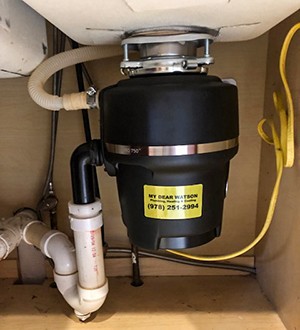Easy-to-Follow Techniques for Repairing a Leaky Garbage Disposal
Easy-to-Follow Techniques for Repairing a Leaky Garbage Disposal
Blog Article
We have unearthed this great article about How to fix a pretty consistent leak from my garbage disposal directly below on the internet and thought it made sense to write about it with you here.

Waste disposal unit are crucial cooking area devices that assist in taking care of food waste efficiently. However, a leaking waste disposal unit can be a discouraging and unpleasant trouble to manage. Luckily, lots of leaks can be taken care of quickly with a couple of easy steps. In this article, we will talk about exactly how to repair a dripping garbage disposal properly.
Introduction
Waste disposal unit are installed under cooking area sinks and are developed to shred food waste right into smaller sized pieces, permitting it to travel through the pipes system conveniently. While these devices are normally trusted, leakages can take place over time because of damage, loose connections, or damages to the device.
Common Sources Of Leakages in Trash Disposals
Worn Seals and Gaskets
Seals and gaskets play an important function in stopping water from dripping out of the garbage disposal. Gradually, these components can weaken, resulting in leakages around the disposal device.
Loose Connections
The connections in between the garbage disposal and the plumbing system can end up being loosened with time, causing water to leak out during operation.
Fractures or Holes in the Disposal System
Physical damages to the waste disposal unit, such as splits or openings in the real estate, can additionally cause leaks.
Identifying the Source of the Leak
Prior to trying to repair a leaking garbage disposal, it is important to identify the resource of the leak. This can normally be done via visual assessment or by performing simple tests.
Visual Examination
Inspect the garbage disposal system thoroughly for any type of indicators of water leak. Pay close attention to areas around seals, gaskets, and connection points.
Evaluating for Leaks
One method to check for leakages is by running water via the disposal device and looking for any visible signs of leak.
Tools and Products Needed for Dealing With a Dripping Garbage Disposal
Before starting the repair process, collect the required tools and products, consisting of a screwdriver, adjustable wrench, plumber's putty, substitute seals or gaskets, and epoxy or patching product for repairing splits or openings.
Step-by-Step Guide to Taking Care Of a Dripping Waste Disposal Unit
Switch off the Power
Prior to attempting any fixings, ensure that the power to the garbage disposal unit is shut off to avoid the threat of electric shock.
Find the Leak
Recognize the precise place of the leakage and identify the reason.
Tighten up Connections
Utilize a wrench to tighten any type of loosened links between the disposal device and the plumbing system.
Change Seals or Gaskets
If the leakage results from used seals or gaskets, eliminate the old components and change them with new ones.
Patching Splits or Holes
For splits or holes in the disposal unit, usage epoxy or a suitable patching product to secure the damaged location.
Testing the Waste Disposal Unit After Repair Work
Once the fixing is full, test the garbage disposal by running water through it to make sure that the leakage has been solved.
Preventive Upkeep Tips to Prevent Future Leaks
To prevent future leakages, it is essential to execute normal upkeep on your waste disposal unit. This consists of keeping it tidy, staying clear of putting non-food items or hard objects down the disposal, and periodically looking for leaks or various other concerns.
Final thought
In conclusion, fixing a leaking waste disposal unit is a fairly simple procedure that can be completed with basic tools and products. By following the steps detailed in this short article and practicing precautionary upkeep, you can maintain your waste disposal unit in good working problem and stay clear of pricey repair work in the future.
HERE’S HOW TO FIX YOUR GARBAGE DISPOSAL
WHAT TO DO IF SOMETHING IS STUCK IN YOUR GARBAGE DISPOSAL
If the impeller won’t turn, there’s probably something stuck in the disposal. It could be a steak bone or peach pit, although plumbers report pulling all sorts of inappropriate objects out of disposals, such as bottle caps or aluminum foil. Make sure power to the disposal is off, and look inside to see if you can see the source of the jam.
Never stick your fingers in a disposal. Pull out anything you see with tongs or pliers.
If the disposal still won’t work, it may be time to call a plumber or consider buying a new disposal. GEM Plumbing & Heating is here for all of your garbage disposal needs.
WHAT TO DO IF YOUR GARBAGE DISPOSAL DRAIN IS CLOGGED
Take everything out from underneath your sink and put a bucket or other container under your disposal to catch any water that drains out. Disconnect your disposal from the power supply. If it’s plugged into a wall outlet, unplug it. If it’s hardwired into an electrical box, go to the electrical panel and turn off the breaker for the disposal. Pour ¼ cup of baking soda into the drain, followed by ½ cup of white vinegar. Give the solution a few minutes to fizz and do its work. Look into the disposal with a flashlight to see if you can see an object that might be causing the clog. If you see it, remove it using tongs or pliers. MORE TIPS ON DEALING WITH A CLOGGED GARBAGE DISPOSAL
Never use drain cleaner in a garbage disposal. It can damage the plastic parts inside the disposal. You can also be splashed with the caustic liquid while working to clear the clog. Beware! Never stick your fingers into a garbage disposal. Trust us — not a good idea. In many instances, your dishwasher drains through your garbage disposal. This allows the disposal to grind any large food particles that may be drained out of your dishwasher. There are some jurisdictions, however, where the plumbing code prohibits such a connection. WHAT TO DO WHEN YOUR DISHWASHER DRAINS THROUGH THE DISPOSAL
Run some water in the sink so your plunger has at least a ½-inch of water to create a seal and plunge vigorously up and down several times. You may need to repeat this several times. Run hot water down the drain to clear any residue that remains.

I found that blog post on Garbage Disposal Leaking From Bottom when doing a lookup on the internet. Liked our blog entry? Please share it. Let someone else locate it. Thanks for taking the time to read it.
Instant Quote Report this page